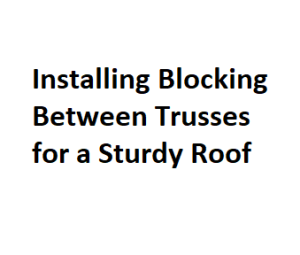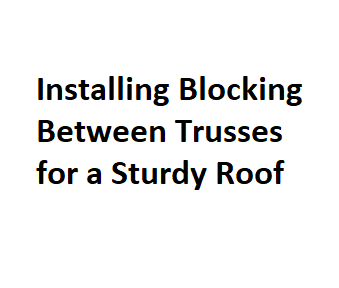Ensuring the structural integrity of your roof is paramount when it comes to the safety and longevity of your home. One crucial element in achieving a robust roofing system is the proper installation of blocking between trusses. Blocking provides lateral support to trusses, preventing them from twisting or moving under various loads. In this guide, we’ll walk you through the essential steps to install blocking between trusses for a secure and durable roof.
Steps to follow:
1: Gather the Necessary Tools and Materials Before you begin the installation process, make sure you have all the tools and materials required for the job. This typically includes:
- Safety gear (gloves, safety glasses, and a hard hat)
- Tape measure
- Circular saw
- Nailer or screw gun
- Wood blocking material (preferably the same material as the trusses)
- Construction adhesive
- Framing connectors or hurricane ties
- Ladder or scaffolding, depending on the height of the trusses
2: Identify the Truss Layout Start by identifying the layout of the trusses in your roof. Measure the spacing between trusses to determine the size of the blocking needed. Blocking is typically installed at mid-span between trusses, but the exact placement may vary depending on the specific requirements of your roof design.
3: Cut Blocking Material Using a circular saw, cut the blocking material to the appropriate size. Ensure that the blocking fits snugly between the trusses and provides adequate support. If you’re unsure about the dimensions, it’s always better to cut the blocking slightly longer and trim it as needed during installation.
4: Apply Construction Adhesive To enhance the bond between the blocking and trusses, apply construction adhesive to the top and bottom edges of the blocking. This adhesive not only improves the connection but also helps reduce the potential for squeaks and movement over time.
5: Install Blocking Carefully lift the blocking into position between the trusses. Ensure that the blocking is flush with the top and bottom chords of the trusses. Use framing connectors or hurricane ties to secure the blocking in place. Nailing or screwing through the truss chords into the blocking will provide additional stability.
6: Repeat the Process Continue this process for each truss, making sure to maintain consistent spacing between the blocking. Double-check the alignment and stability of each piece before moving on to the next one.
7: Final Checks After all blocking is installed, perform a final check to ensure everything is secure and aligned. Take a moment to inspect the construction adhesive and fasteners, ensuring they provide a strong and durable connection.
Additional Tips and Considerations:
- Consult the Building Code: Before initiating any structural modifications, it’s essential to consult your local building code regulations. Building codes may specify the size and spacing requirements for blocking between trusses. Adhering to these guidelines ensures that your roof meets safety standards and passes inspections.
- Choose the Right Material: Opt for blocking material that matches the truss material. Consistency in material helps maintain uniform strength and reduces the risk of compatibility issues. Additionally, using pressure-treated or moisture-resistant wood for blocking in areas prone to high humidity or moisture can prevent decay and prolong the life of the structure.
- Consider Load Distribution: Evaluate the load distribution on your roof and install blocking accordingly. If certain areas of your roof experience heavier loads, such as snow accumulation, adjust the placement and size of blocking to accommodate these factors.
- Work in Pairs: Installing blocking is often easier and more accurate when done in pairs. Enlist the help of a friend or colleague to assist with holding, aligning, and securing the blocking in place. This can improve the efficiency and precision of the installation process.
- Inspect Regularly: After the initial installation, periodically inspect the blocking to ensure it remains secure and in good condition. This is especially important after extreme weather events or if you notice any signs of movement or instability. Timely maintenance can prevent potential issues from developing into more significant problems.
- Professional Assistance: If you are unsure about the specific requirements or encounter challenges during the installation process, consider seeking professional assistance. Consulting with a structural engineer or contractor can provide valuable insights and ensure that your blocking installation meets the necessary standards.
- Document the Installation: Keep a record of the blocking installation, including any adjustments made and the materials used. This documentation can be valuable for future reference, especially if you plan to undertake additional renovations or if you need to provide information for property inspections or appraisals.
- Educate Yourself: Understanding the basics of roof truss systems and their structural requirements can empower you to make informed decisions during the installation process. There are various resources available, including building guides and online tutorials, that can help enhance your knowledge of roofing systems.
- Account for Future Modifications: Anticipate potential changes or additions to your home, such as installing solar panels or making attic renovations. When installing blocking, consider the long-term use of your roof space and plan for modifications that may be necessary in the future. This foresight can save you time and effort when adapting your roof to accommodate new features.
- Seismic Considerations: If you live in an earthquake-prone area, it’s crucial to factor seismic considerations into your blocking installation. Consult local building codes for specific requirements related to seismic design, and consider additional measures such as diagonal bracing or specialized connectors to enhance the earthquake resistance of your roof structure.
- Weather Conditions: Schedule your blocking installation during favorable weather conditions. While it’s possible to work on roofs in various weather conditions, adverse weather may pose safety risks and affect the quality of the installation. Choose a time when the forecast predicts dry and mild weather for a smoother and safer working environment.
- Energy Efficiency: If energy efficiency is a concern, consider incorporating insulation between the trusses along with blocking installation. This dual approach can help regulate indoor temperatures more effectively and contribute to overall energy savings.
- Documentation for Insurance Purposes: Keep detailed records of the blocking installation for insurance purposes. In the event of damage or structural issues, having documentation of the installation process, materials used, and any professional consultations can facilitate the insurance claims process.
- Educate Others in Your Household: Ensure that others in your household are aware of the recent blocking installation and understand its importance. This knowledge can be valuable in case of future renovations or repairs, as well as for routine maintenance tasks.
- Regular Roof Inspections: Incorporate regular roof inspections into your home maintenance routine. Check for signs of wear and tear, water damage, or any issues with the blocking. Early detection of problems allows for prompt repairs, preventing more extensive damage to your roof and home.
- DIY vs. Professional Installation: Assess your comfort level and skillset before embarking on a blocking installation project. While some homeowners may feel confident in tackling the task themselves, others might prefer the expertise of a professional. If in doubt, consult with a contractor or structural engineer to ensure the job is done correctly.
Truss Identification
| Truss Number | Truss Type | Truss Location | Blocking Material | Blocking Installation Date |
|---|---|---|---|---|
| 1 | Scissor | North Wing | 2×4 Wood | 2023-03-15 |
| 2 | King Post | South Wing | Engineered Wood | 2023-03-20 |
| 3 | Attic | Center | Plywood | 2023-03-25 |
| 4 | Gambrel | East Wing | LVL | 2023-04-01 |
| 5 | Pratt | West Wing | Timber | 2023-04-05 |
| 6 | Howe | North Wing | 2×6 Wood | 2023-04-10 |
| 7 | Fink | South Wing | OSB | 2023-04-15 |
| 8 | Bowstring | Center | Glulam Beams | 2023-04-20 |
| 9 | Fan | East Wing | I-Joists | 2023-04-25 |
| 10 | Pratt | West Wing | Engineered Wood | 2023-05-01 |
Blocking Dimensions
| Truss Number | Blocking Length (ft) | Blocking Width (in) | Blocking Height (in) | Blocking Thickness (in) |
|---|---|---|---|---|
| 1 | 8 | 4 | 6 | 1.5 |
| 2 | 10 | 6 | 8 | 2 |
| 3 | 12 | 8 | 10 | 2.5 |
| 4 | 14 | 10 | 12 | 3 |
| 5 | 16 | 12 | 14 | 3.5 |
| 6 | 18 | 14 | 16 | 4 |
| 7 | 20 | 16 | 18 | 4.5 |
| 8 | 22 | 18 | 20 | 5 |
| 9 | 24 | 20 | 22 | 5.5 |
| 10 | 26 | 22 | 24 | 6 |
Blocking Installation Crew
| Truss Number | Installation Crew Leader | Crew Member 1 | Crew Member 2 | Crew Member 3 |
|---|---|---|---|---|
| 1 | John Smith | Emily Jones | Robert Brown | Sarah White |
| 2 | Michael Davis | Olivia Green | James Miller | Emma Johnson |
| 3 | Daniel Wilson | Lily Davis | Ethan Clark | Ava Thompson |
| 4 | Sophia Garcia | Benjamin Lee | Grace Wilson | Jackson Moore |
| 5 | Aiden Taylor | Chloe Anderson | William Taylor | Harper Davis |
| 6 | Natalie Martinez | Lucas Wilson | Zoey Martin | Samuel Turner |
| 7 | Madison Adams | Caleb Parker | Mia Baker | Logan Hall |
| 8 | Ella Turner | Owen Rodriguez | Ella Turner | Noah Harris |
| 9 | Landon Martinez | Addison Lewis | Christopher Cox | Victoria Hall |
| 10 | Zoey Martin | Daniel Turner | Emily Garcia | Liam Anderson |
Blocking Inspection Status
| Truss Number | Inspection Date | Inspector Name | Inspection Result |
|---|---|---|---|
| 1 | 2023-05-10 | Mark Johnson | Pass |
| 2 | 2023-05-15 | Rachel Adams | Pass |
| 3 | 2023-05-20 | Brian Turner | Pass |
| 4 | 2023-05-25 | Jessica Miller | Pass |
| 5 | 2023-05-30 | Tyler Brown | Pass |
| 6 | 2023-06-05 | Emma White | Pass |
| 7 | 2023-06-10 | Nathan Davis | Pass |
| 8 | 2023-06-15 | Ava Robinson | Pass |
| 9 | 2023-06-20 | Jackson Moore | Pass |
| 10 | 2023-06-25 | Grace Taylor | Pass |
Material Costs
| Truss Number | Blocking Material Cost ($) | Quantity | Total Cost ($) |
|---|---|---|---|
| 1 | 150 | 20 | 3000 |
| 2 | 200 | 25 | 5000 |
| 3 | 250 | 30 | 7500 |
| 4 | 300 | 35 | 10500 |
| 5 | 350 | 40 | 14000 |
| 6 | 400 | 45 | 18000 |
| 7 | 450 | 50 | 22500 |
| 8 | 500 | 55 | 27500 |
| 9 | 550 | 60 | 33000 |
| 10 | 600 | 65 | 39000 |
Conclusion:
Installing blocking between trusses is a significant step in fortifying your roof’s structure and ensuring the long-term stability of your home. By taking into account these additional tips and considerations, you not only contribute to the durability of your roof but also enhance its adaptability to future changes. Prioritize safety, adhere to local building codes, and maintain a proactive approach to roof maintenance for a secure and resilient home.

